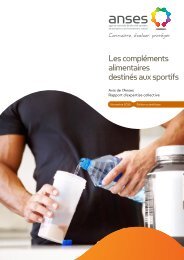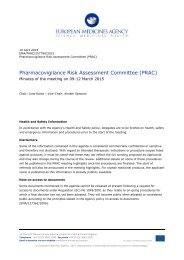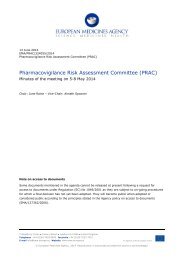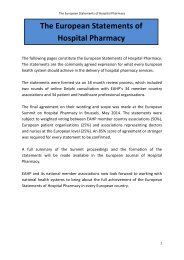WC500165698
WC500165698
WC500165698
Create successful ePaper yourself
Turn your PDF publications into a flip-book with our unique Google optimized e-Paper software.
Summary of recommendation(s)<br />
<br />
The MAH for Stivarga (regorafenib) should submit to the EMA within the next PSUR (DLP<br />
26/03/2014), a cumulative review of all cases suggestive of this suspected adverse drug<br />
reaction, from spontaneous reports, from clinical trials as well as from the literature.<br />
4.1.4. Tacrolimus - ADVAGRAF (CAP), MODIGRAF (CAP), NAP<br />
Febuxostat – ADENURIC (CAP)<br />
<br />
Signal of potential drug-drug interaction between systemic tacrolimus and febuxostat<br />
Regulatory details:<br />
PRAC Rapporteur: Almath Spooner (IE)<br />
Administrative details:<br />
EPITT 17809 – New signal<br />
MAH(s): Astellas Pharma Europe B.V. (Advagraf, Modigraf), Menarini International Operations<br />
Luxembourg S.A. (Adenuric), various<br />
Background<br />
Tacrolimus is a calcineurin inhibitor used in the prophylaxis of transplant rejection in adult kidney or<br />
liver allograft recipients and for the treatment of allograft rejection resistant to treatment with other<br />
immunosuppressive medicinal products in adult patients. Febuxostat is a xanthine oxidase inhibitor<br />
authorised for the treatment of chronic hyperuricaemia in conditions where urate deposition has<br />
already occurred (including a history, or presence, of tophus and/or gouty arthritis).<br />
During routine signal detection activities, a signal of drug-drug interaction between systemic tacrolimus<br />
and febuxostat was identified by the UK, based on an individual case reported in the United Kingdom<br />
and further cases retrieved from EudraVigilance. The Rapporteur confirmed that the signal needed<br />
initial analysis and prioritisation by the PRAC.<br />
Discussion<br />
The PRAC discussed the information on the cases of suspected interaction between tacrolimus and<br />
febuxostat leading to an increase in tacrolimus blood concentrations. The PRAC commented that a<br />
particular underlying mechanism was not obvious, the number of cases was small in absolute terms<br />
and the detail provided was quite limited.<br />
However, the identified time to interaction seemed plausible and positive dechallenge information<br />
(further normalisation of blood levels after febuxostat dechallenge or tacrolimus dose reduction) was<br />
present. The suspected interaction, if confirmed, could be potentially medically important as tacrolimus<br />
is a medicine with a narrow therapeutic index and maintenance of whole blood tacrolimus<br />
concentrations within the therapeutic range is required to avoid toxicity and graft rejection linked to<br />
overdosing and under dosing, respectively. The consequences of overdose are primarily renal<br />
impairment; however other manifestations of toxicity include nausea, vomiting, tremor and elevated<br />
liver enzymes. Investigation of the potential for an interaction is also clinically relevant in the context<br />
of real world use as gout is a common problem among the population of renal transplant patients with<br />
a prevalence of 2 to 13% 5 (although the use of febuxostat in organ transplant recipients is not<br />
recommended in section 4.2 of the Summary of Product Characteristic (SmPC) of Adenuric as there is<br />
no experience with febuxostat in this patients population).<br />
5 JASN 2000 vol.11 no. 5 974-979<br />
Pharmacovigilance Risk Assessment Committee (PRAC)<br />
EMA/PRAC/253432/2014 Page 17/64








